How to Pick Motors, Propellers, ESCs, and Lipo Batteries For Your FPV Quad - FPV Powertrain
So you know what kind of FPV quad you want to build and fly, but what are the parts you need? Find out how to pick your FPV quad's powertrain parts
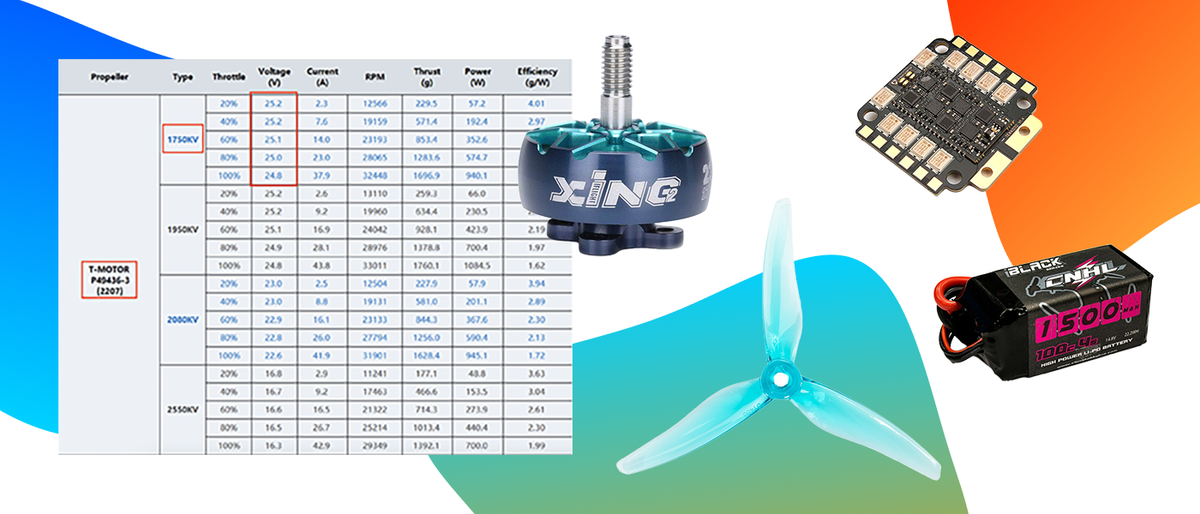
So you know what kind of FPV quad you want to build and fly, but what are the parts you need? In our issue for beginners on picking FPV parts, we provided some general guidelines on what to choose for your entire quad. In this issue, we’re going over how motors, propellers, ESCs, and lipo batteries all work together. We consider these parts the powertrain or drivetrain of your quad — the parts that directly correlate to how your quad performs.
At this stage of the FPV hobby, there are two common approaches to picking these FPV powertrain parts:
- Find a parts list for a quad that someone else built and adjust to your liking based on the availability of those parts.
- Calculate the thrust-to-weight ratio of your potential quad build by adding up the total weight of your quad components (all-up weight; AUW) and comparing it to the estimated thrust for your motor/prop/lipo battery combination.
We’ll be doing the latter in this issue to demonstrate how the combination of these parts work together to affect how quad. By calculating your quad’s thrust-to-weight ratio, you can get a good idea of how light or heavy your quad feels while in the air.
Motors
Calculating Thrust-to-Weight Ratio For FPV Quads
You can easily calculate a quad’s all-up weight by adding up all the weight information of your parts and payload (like a GoPro if you intend to fly with one) in grams. Then add another 20-25 grams for wiring and ancillary parts like battery straps.
Understandably, if you haven’t chosen any parts yet other than your frame, you can estimate this and adjust it later. If you've chosen the other parts for your quad, like the flight controller or video transmitter, use the product information to find out how many grams each one of these parts weigh.
Calculating thrust without buying the parts first and doing your own tests is more tricky. So we can only estimate thrust with available product information. This estimating method is great because it's easy to do and gives you a good idea of how much thrust to expect. You can use this method with any motor that provides thrust table data. Alternatively, you can Google thrust tests for motors that others have already performed.
To estimate thrust without buying your parts first, you need to go to the motor’s product details and view the thrust tables. These tables give you information on how the motors perform with a specific combination of prop and battery. Look for the maximum thrust in grams at maximum throttle for a particular prop and battery combo.
Example Thrust-to-Weight Ratio Calculation:
Let’s say we estimated the all-up weight of our 5-inch quad to come out to 700g.
Using our guidelines for motors, we know 2207 motors are typically good for 5-inch quads. So we found the T-Motor Pacer V3 P2207. Scrolling down on the product page, we found the table below that details a propeller, the Kv variation of that motor, throttle at x voltage, and the thrust (boxed in red).
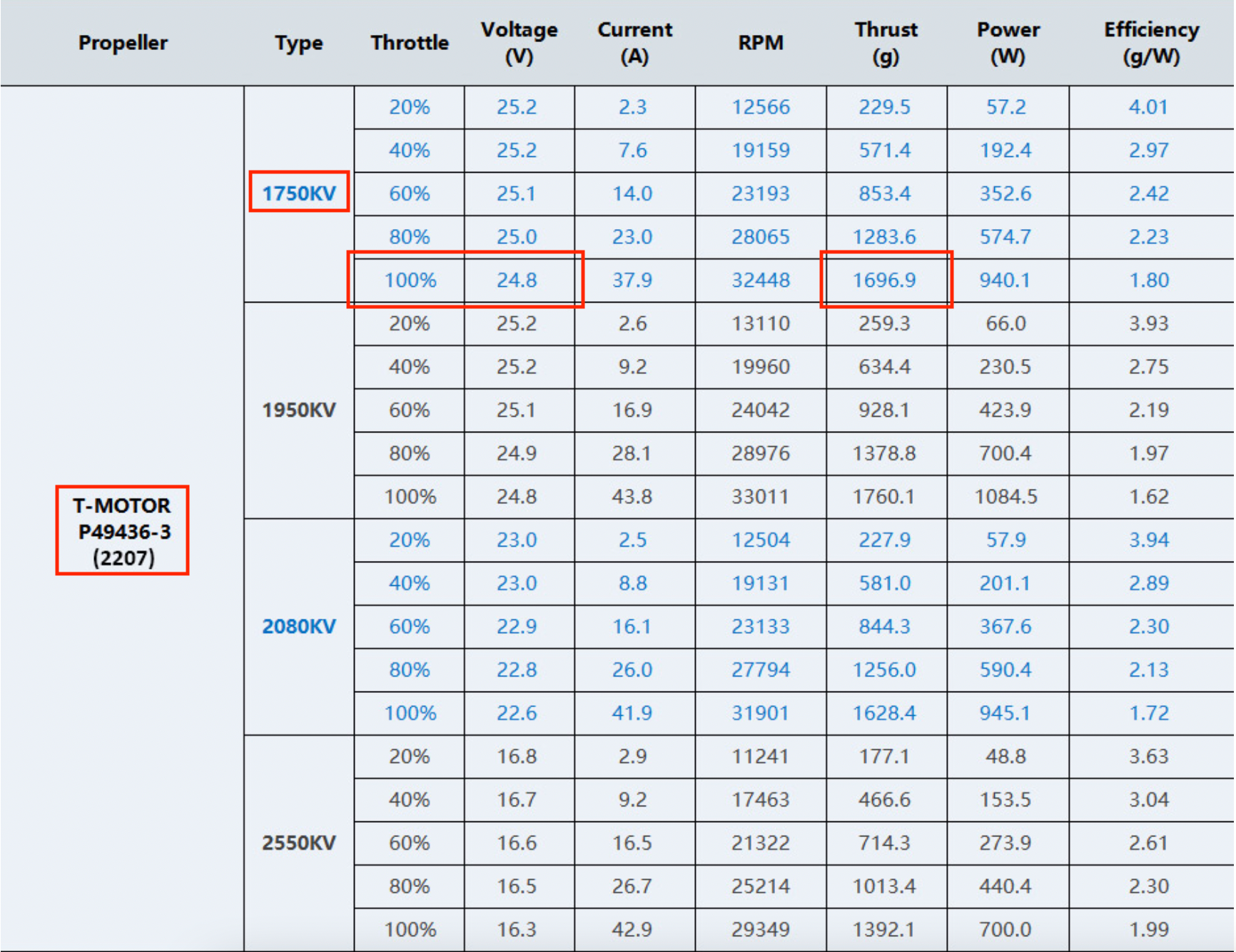
In this example, we have our T-Motor Pacer 2207 motors paired with the T-Motor P49436-3 propellers, and 6S battery (denoted by the voltage). For this specific combination, we can see the thrust is 1696.9g. Since we're building a quad copter, we'll multiply that by 4, which equals 6787g of thrust.
So for this combination, we get a quad with:
1696.9g of thrust * 4 motors : 700g all-up weight
or
6787g of thrust : 700g all-up weight
or
9.7 : 1 thrust-to-weight ratio
With your thrust-to-weight information, you can determine if this is the kind of quad you want. In most cases, you should plan for at least a 2:1 ratio which allows your quad to hover at half-throttle. Depending on what kind of flying you want to do, you can adjust your motor needs by doing this exercise. You can also swap out parts to reduce or increase your all-up weight for a different feel.
The higher the thrust-to-weight ratio, the more responsive your quad will be. Freestylers and racers tend to build quads with high ratios, while cinematic pilots look for lower ratios for more controlled flying. Cinematic flyers may want something close to 2:1. Freestyle pilots routinely use quads between 3:1 - 7:1. And it's not uncommon to see quads with a 15:1 ratio or higher.
By calculating your potential quad's thrust-to-weight ratio, you establish a baseline to measure your future builds against. For your first build, it's about making a strong educated guess and adjusting from there. Once you build your quad and fly it, you'll be able to experience how your quad's thrust-to-weight ratio feels, and you can use that feel to determine the ratio you want in a rebuild or your next build.
Using the same principles, you can use a thrust-to-weight calculator to play around with the numbers. A more advanced calculator can be found here.
Motor Kv
We want to mention motor Kv, but for the purposes of the example we've illustrated in this issue, there aren't meaningful differences when comparing motor Kv between types of motors.
Check out our beginner’s guide on motor Kv to learn more.
For our example quad, we decided on these T-Motor 2207 1750Kv motors because we like that our calculations landed on a thrust-to-weight ratio of almost 10:1.
Propellers
Now that you’ve chosen your motors and know what kind of propellers were used to calculate your quad's estimated thrust, you can either choose the same props (or props with the same length, pitch, and blades) to get the thrust-to-weight ratio you calculated earlier, or you can use this opportunity to tweak and achieve a larger or smaller thrust-to-weight ratio.
Length and Pitch
Generally, longer props and pitch mean more speed at the expense of more power draw. And shorter prop length and pitch spin faster and are more responsive.
Blade Count
It's very common to fly with 2 or 3-blade propellers. The fewer the blades on the props, the more efficient and less power intensive the quad. With more prop blades, the quad gets more inefficient while drawing more power.
Blade Shape
Blades can be narrow and pointy, or fat and stubby. Bullnose-shaped props offer more thrust, but draw more power. And regular pointed props can be weaker, but draw less power.
For this example quad, because the T-Motor P49436 prop wasn't available, we chose a similar one, the T-Motor P4943 prop, which shares the same length and pitch. This allows us to maintain the estimated thrust-to-weight ratio that we calculated earlier.
ESC
Amp Rating
The most important factor when selecting an ESC is the amp rating. When you look at the specs for an ESC, it will denote whether it’s 15A, 30A, 40A, etc. The amp rating refers to the continuous amps your ESC can handle.
ESCs have two amp ratings, the continuous rating and the burst rating. The continuous rating refers to how many amps your ESC can draw continuously. This correlates to the current you draw during most of your flight. Your ESC also has a burst rating which refers to how many amps your ESC can draw for just a couple seconds at a time, like when you throttle to 90-100%.
Both of these amp ratings are important because if your ESC's amp rating is too small, it may fry or fire, especially under high throttle situations.
In our Beginner’s Guide, we provided general guidelines based on frame size. In this issue, we’re diving deeper to determine what kind of ESC you’ll need based on your motor and propeller choice.
To do this, let's go back to our chosen motor’s thrust table and look at the column for Throttle and Current.
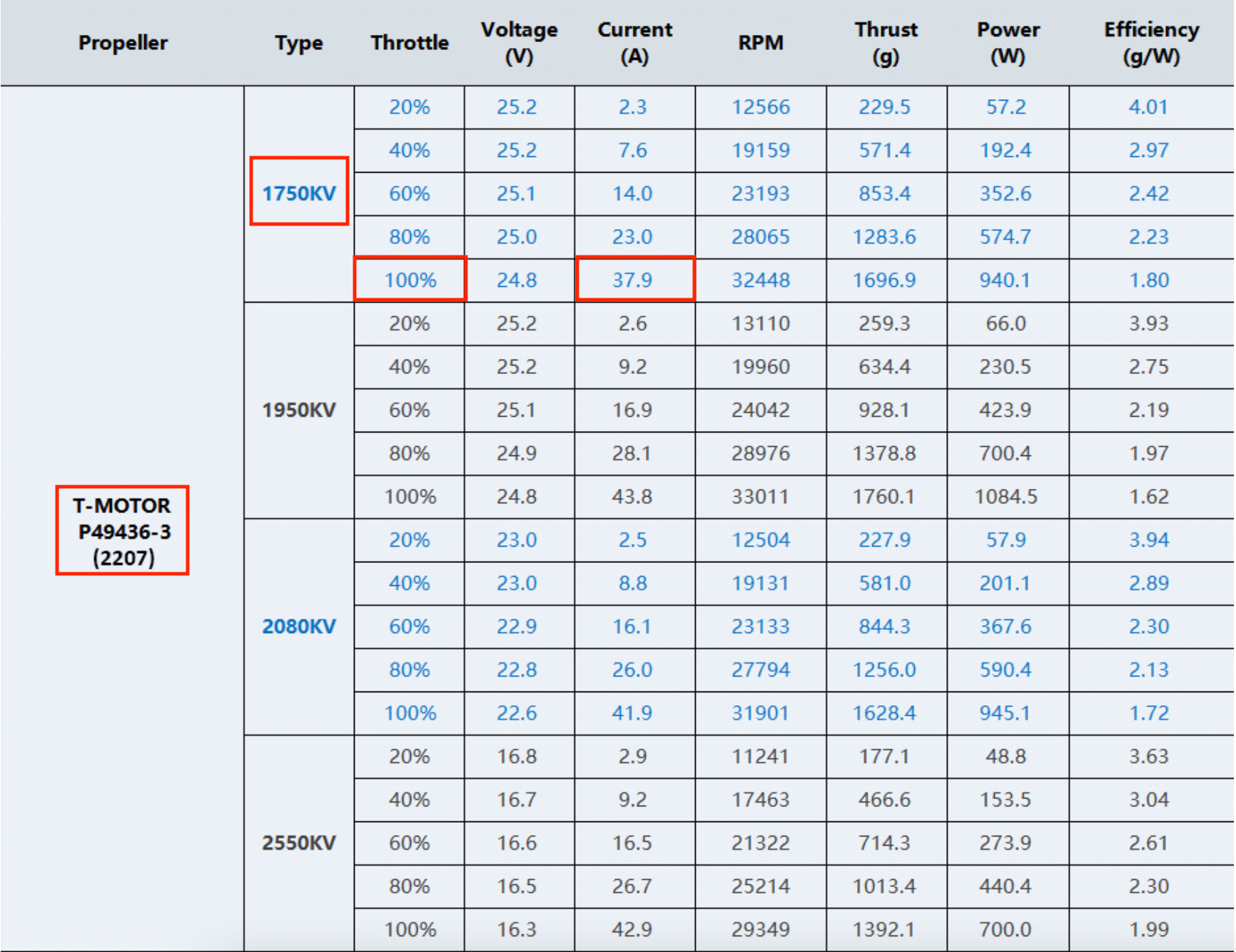
100% throttle can refer to your burst rating because you’ll rarely put in 100% for sustained amounts of time. Looking over to the Current column, you can see that at 100% throttle, this quad requires 37.9A current draw. This means that with this motor/prop combo, you need to choose an ESC with a burst rating of at least 37.9A.
To determine the continuous amps you need for an ESC, you can conservatively use the amp draw at 80% throttle. So for our example motor/prop combo, we would need an ESC that is rated for at least 23A continuous. Some pilots use the amp draw at 50% or 60% which is totally fine too. We just lean a bit more conservative to save us the hassle of a potentially ruining our ESC and other parts.
But wait! Using this method only gives you an estimate. Even if you're perfectly accurate, you may, one day, decide on swapping to different props or different motors, so you want to future-proof your ESC. The general best practice is to pick an ESC rated for a slightly higher amperage than what your motor and propeller combo will draw continuously and during bursts.
So going back to our example, for our motor/prop combo, we chose an ESC that is rated for 30A continuous, and 45A burst. Depending on your flying style and risk tolerance, you may choose to be more aggressive or conservative when determining your ESC’s amp rating.
Mount
If you’re using a 4-in-1 ESC, ensure that it’s mount size matches your flight controller and frame.
Lipo Input
In most cases, you’ll be fine, but it’s a good idea to ensure that your ESC supports your lipo’s cell count. Some ESCs support up to 4-cell lipos, while others up to 6-cell lipos.
Lipo Battery
Speaking of lipos, choosing the right lipo battery for your quad means ensuring that you have the correct cell count for your motor and ESC combo, and finding a good balance between capacity, discharge rate, and weight.
Cell Count (S)
Since we’ve chosen our motors already, we can go back to our motor’s thrust table and see what voltages were being run and use that to determine what cell count lipo was used.
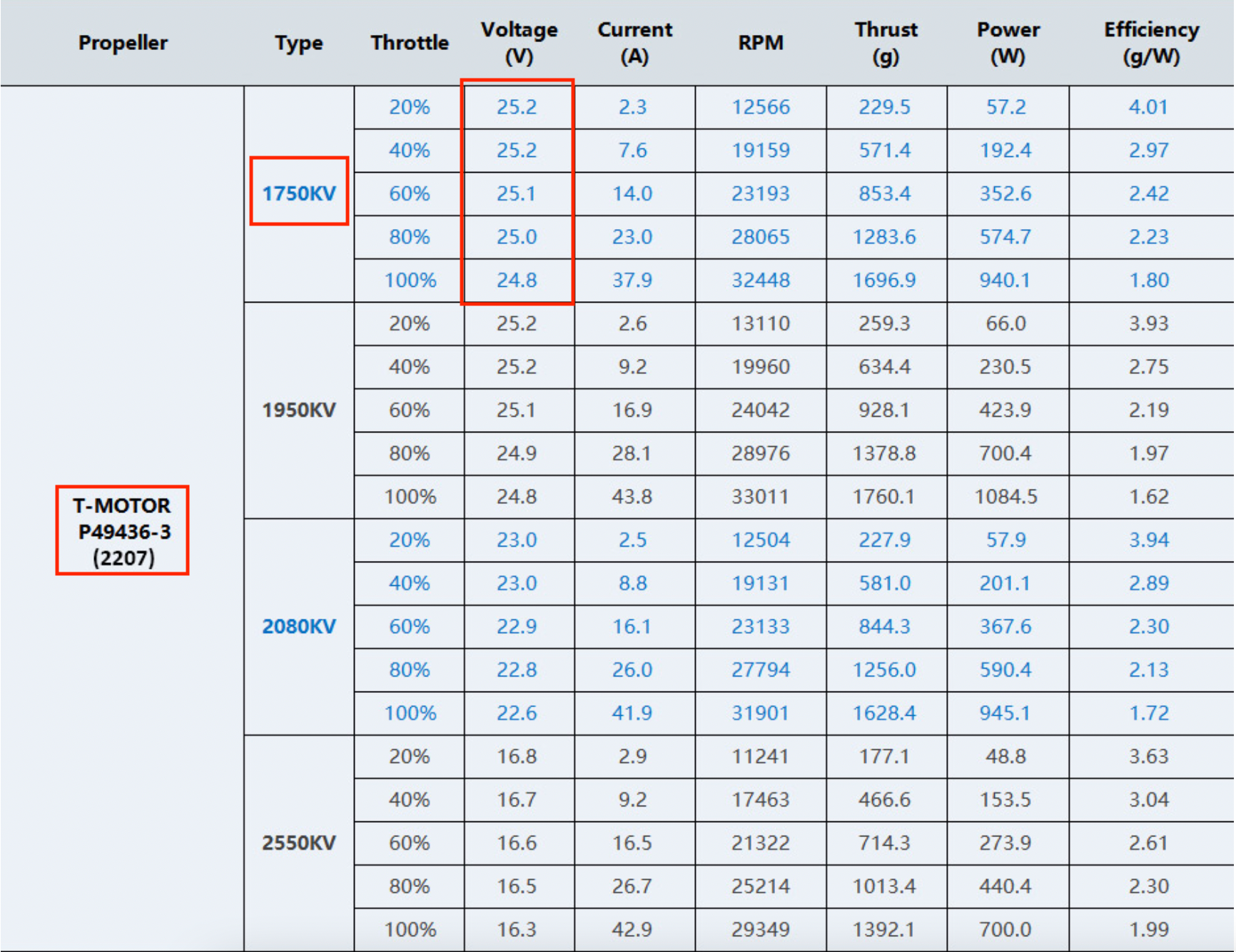
By looking at the voltage column for our 1750Kv motor, we can see that voltage ranges between 24.8 - 25.2V. A fully charged 6S lipo is 25.2V, so it’s safe to assume that we should get 6S lipos for this build. Looking at our motor’s thrust table, only the 2550Kv variation was tested with a 4S, 16.8V lipo.
Here is a handy guide on lipo cell count and voltage:
| Lipo Voltage Table | ||||||
|---|---|---|---|---|---|---|
| Cell Count | 1S | 2S | 3S | 4S | 5S | 6S |
| Nominal Voltage | 3.7V | 7.4V | 11.1V | 14.8V | 18.5V | 22.2V |
| Fully-charged Voltage | 4.2V | 8.4V | 12.6V | 16.8V | 21V | 25.2V |
Capacity (mAh)
The lipo’s capacity is correlated to how long you can fly. This isn’t so much a science, and most pilots follow roughly the same guidelines. The quad's lipo battery is one of the heaviest components of a quad. The larger the capacity, the heavier the battery. Therefore, having a larger battery may not get you longer flight times, because the extra weight diminishes any gains from the extra capacity. Generally, the weight of your battery should weigh about half as much as the dry-weight of your quad.
Here are some guidelines based on frame/prop size:
| Lipo Capacity Table | |
|---|---|
| Quad / Prop Size | Lipo Capacity Range |
| 2.5in or smaller | 200 - 500 mAh |
| 3in | 650 - 1000 mAh |
| 4in | 850 - 1300 mAh |
| 5in | 1000 - 1800 mAh |
| 6in+ | 1500 mAh+ |
Since we are building a 5 inch quad, we chose a 1500mAh lipo.
Discharge Rate (C)
The lipo’s discharge rate refers to the maximum current you can draw from it without potentially damaging it. We can easily measure our discharge rate going back to our example motor’s thrust table and using this formula to calculate burst and continuous current draw:
Continuous C Rating = 50% of Burst C Rating = Max Current Draw / Capacity
Continuous 49C = Burst 98C = (37.9V * 4 motors) / 1500mAh (1.5Ah)
While calculating discharge rate to ensure compatibility is useful, note that almost all lipos are rated for at least 50C. In fact, take this with a grain of salt because many manufacturers, especially lesser-known ones, have in recent years inflated the C rating for marketing. These calculations come in most handy when you’re doing very high-throttle flying and want to ensure that your lipo and ESC can handle it.
For this example quad, we’ve selected a 6S, 1500mAh, 75C lipo battery.
Summary
How We Chose Our Motors, Propellers, ESC, and Lipo Batteries
Knowing what kind of flying we want to do, we started out with a frame in mind. We also had an idea of what radio receiver, VTX, flight controller, antennas, FPV camera we wanted to use.
We estimated the total all-up weight of our quad in grams.
We browsed for motors within the range for our size quad, and used motors' thrust tables to estimate the thrust for several motors.
We calculated our quad's thrust-to-weight ratio using the two numbers above.
We chose propellers similar to those in the motor thrust table to maintain a similar thrust-to-weight ratio.
We chose an ESC by determining the necessary continuous and burst amp ratings from the motor thrust table, and selecting an ESC with a slightly higher amp rating.
Using the thrust tables, we first chose our motors, then the lipo battery with a cell count to match. Then we chose the capacity of the lipo by using general guidelines for a 5in quad.
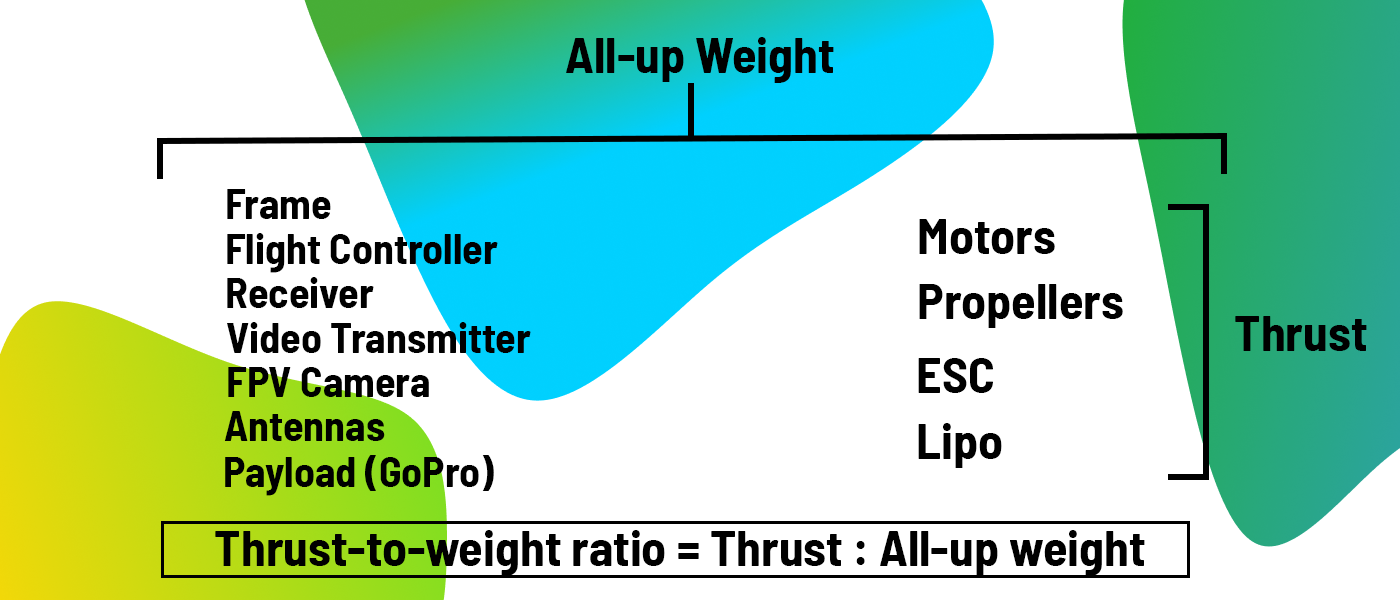
The Powertrain Parts We Chose
Motors - 2207, 1750Kv (4x)
Props - 4.9in length, 4.3in pitch, 3-blade (2x CW, 2x CCW)
ESC - 30A continuous, 45A burst
Lipo - 6S, 1500mAh, 75C
The Many Ways to Choose Motors
In this issue, we demonstrated one method for beginners to be able to assess what motors to choose. We admit this is not the perfect and all-encompassing way to choose motors, but this method allows first-time builders to establish a baseline for themselves and provides a process to choose the parts needed to build a flyable quad.
We also want to mention a couple other resources if you want to go more in-depth on motors:
- Joshua Bardwell's guide on calculating motor volume to determine torque and recommended stator size against prop size.
- Chris Rosser's guide on the physics of motors.
- MiniQuadTestBench database for thrust tests.
- The Drone Dojo's guide on motor thrust.
Now that you know how to estimate thrust-to-weight ratios using readily available product information and motor thrust tables, you have the tools available to spec any type of quad out. You can adjust this process to prioritize certain quad parts and still get a good idea of how your quad will feel. Use QuadPartPicker to spec out the perfect quad for you.
